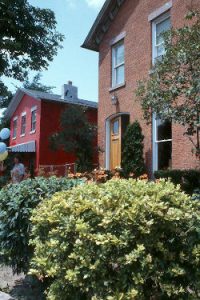Benefits and Responsibilities of Preservation Districts
 Living in a local preservation district has unique benefits. One is knowing that the city thinks your neighborhood is special, and has spent a significant amount of effort researching its architecture and history. But a greater benefit is economic: your property investment is protected from a bad construction or repair job nearby. Because all changes to the exterior of each property in a district must receive approval from the city, your neighbor can’t build that garish addition right next to your Tudor Revival home. While an addition can be built (assuming all other zoning laws are met), the city ensures that it fits into the aesthetic context of the district. As a result, properties in preservation districts have higher values and sales potential than similar properties elsewhere, as shown in national statistics.
Living in a local preservation district has unique benefits. One is knowing that the city thinks your neighborhood is special, and has spent a significant amount of effort researching its architecture and history. But a greater benefit is economic: your property investment is protected from a bad construction or repair job nearby. Because all changes to the exterior of each property in a district must receive approval from the city, your neighbor can’t build that garish addition right next to your Tudor Revival home. While an addition can be built (assuming all other zoning laws are met), the city ensures that it fits into the aesthetic context of the district. As a result, properties in preservation districts have higher values and sales potential than similar properties elsewhere, as shown in national statistics.
The law that governs the districts is Rochester’s Preservation Ordinance. Under the ordinance, a property owner is responsible for getting approval for any alterations to the exterior of his or her property. Approval is required for all non-maintenance exterior work, including demolition, any alteration, any removal of features, and major landscaping. Painting is regulated only on buildings that are individual landmarks, including those that are within preservation districts.
Approval is granted in the form of a Certificate of Appropriateness, once an application is made to the city’s Bureau of Buildings and Zoning. The name of the certificate is telling: the new work must be appropriate to the property and to nearby properties. That is, it must “fit” aesthetically with its surroundings. Because it is sometimes difficult to define “fit”, most applications are reviewed by the Rochester Preservation Board.
The Preservation Board is made up of city residents with knowledge of preservation, architecture and landscape architecture, and an interest in protecting our historic neighborhoods. All members are appointed by the mayor and confirmed by City Council. By law, the board must have at least one registered architect, four residents of city preservation districts, one member of the greater Rochester Association of Realtors, and one member of the Landmark Society. The Board meets once each month, usually the first Wednesday evening, to review and rule on applications.



